A Visit to Scotland - Culloden Moor
I've had so much interest in my recent trip to Scotland and Ireland that I thought it was a good time to revive my blogging skills. I'll begin with Scotland and Culloden Moor.
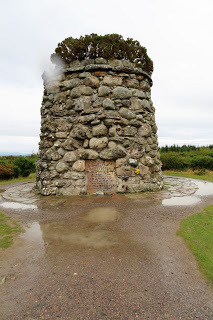 Monument to The Battle of Culloden
Monument to The Battle of Culloden
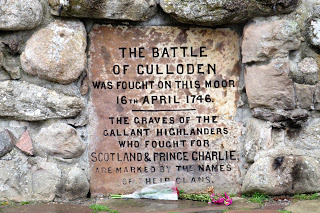
It was a thrill to visit Culloden Moor for several reasons. First, it has historical significance to my ancestors and southwestern Virginia. I swear there are as many, if not more, redheads here than in Scotland and Ireland! I also am a big fan of the Outlander series. If you're not a fan, just know that Outlander is a series of books by Diana Gabladon, currently totaling 8, with number 9 coming soon. Outlander is also a TV series on Starz, but this is not a blog about Outlander! I mention it because preparations for the Battle of Culloden Moor begin at the end of season 2 (Dragonfly in Amber) with the battle taking place at the beginning of season 3 (Voyager). A battle they recreated on Culloden Moor that is near Inverness, Scotland.
Historical Significance of Culloden Moor
As is inscribed on the stone monument pictured above, the Battle of Culloden took place 16 April 1746. It was the last battle fought on British soil. It was also the last in a series of battles between the Jacobites and the British that ended the hope of putting James Stuart, a Catholic, on the throne in England, and thus overthrowing the Hanover kings. James Stuart was exiled in Italy, and his supporters were called Jacobites. The Jacobite rising began in 1745 led by James Stuart's son, Charles Edward Stuart, who first tried raising support in France before turning to the Catholic clans of Scotland.
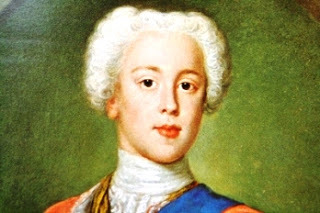 Charles,whose looks had earned him the description bonnie, the Scottish word for pretty, was known as "Bonnie Prince Charlie" and the "The Young Pretender". Charles first went to France, but the ships he obtained were damaged by storms, so he was forced to abandon France and travel to Scotland. He had many clans who supported him, Catholic and Protestant, so he was able to raise an army of approximately 6,000. Charles was only 26 and lacked military skills, and the victory of early battles such as Prestonpans spurred him on, but the Duke of Cumberland, who was King George II's son, was in hot pursuit. He caught up with him on Culloden Moor, 16 April 1746.
Charles,whose looks had earned him the description bonnie, the Scottish word for pretty, was known as "Bonnie Prince Charlie" and the "The Young Pretender". Charles first went to France, but the ships he obtained were damaged by storms, so he was forced to abandon France and travel to Scotland. He had many clans who supported him, Catholic and Protestant, so he was able to raise an army of approximately 6,000. Charles was only 26 and lacked military skills, and the victory of early battles such as Prestonpans spurred him on, but the Duke of Cumberland, who was King George II's son, was in hot pursuit. He caught up with him on Culloden Moor, 16 April 1746.
Culloden Moor
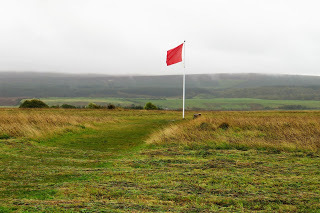
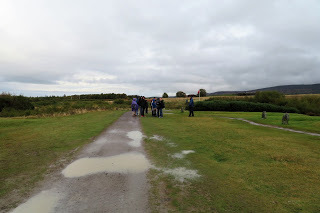
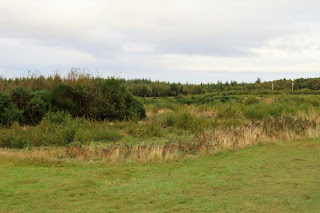 In the distance are Scotland's flags, marking where the Jacobites stood for battle.
In the distance are Scotland's flags, marking where the Jacobites stood for battle.
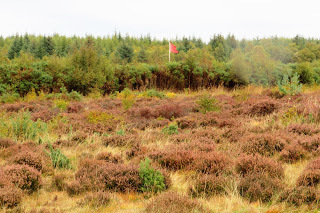 Prince Charles chose to fight on this flat, boggy land against the advice of his generals, one of which was Lord George Murray. The British had cannons, and the red flags in the pictures show where the British army amassed. The British had 8,000 soldiers. The Jacobites had about 5,000 which consisted of some Irish and French. The Jacobites did have muskets and some artillery, but due to the boggy ground, they had trouble transporting it. The Scots had 200 mounted men to Britian's 800. Many historians believe it was the benefit of Dragoons on horseback with swords and blades that was the biggest advantage in the fight.
Prince Charles chose to fight on this flat, boggy land against the advice of his generals, one of which was Lord George Murray. The British had cannons, and the red flags in the pictures show where the British army amassed. The British had 8,000 soldiers. The Jacobites had about 5,000 which consisted of some Irish and French. The Jacobites did have muskets and some artillery, but due to the boggy ground, they had trouble transporting it. The Scots had 200 mounted men to Britian's 800. Many historians believe it was the benefit of Dragoons on horseback with swords and blades that was the biggest advantage in the fight.
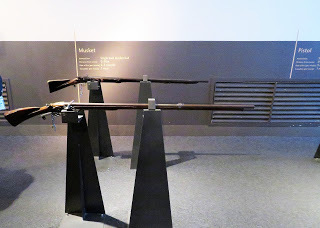
The battle ground has large stones with the names of Scottish clans that mark the places where the clansmen are buried in mass graves. It is estimated that between 1,500 to 2,000 Jacobites were killed, and 154 were captured. Most of those captured were executed.
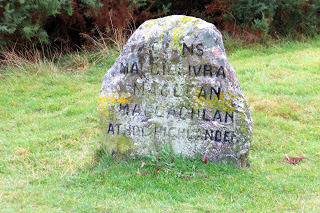 This stone has several clan names with one familiar to me in southwestern Virginia: McClanahan.
This stone has several clan names with one familiar to me in southwestern Virginia: McClanahan.
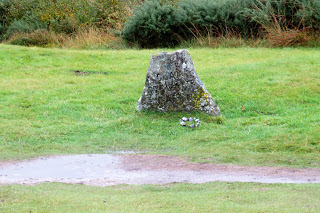 Clan Stewart of Appin
Clan Stewart of Appin
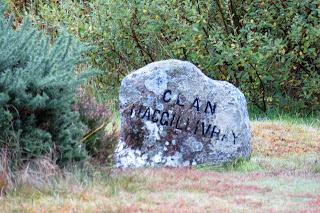 Clan MacGillivray
Clan MacGillivray
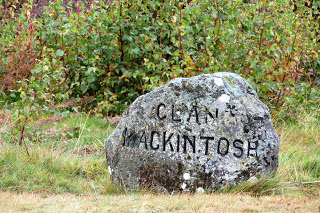 Clan MacKintosh
Clan MacKintosh
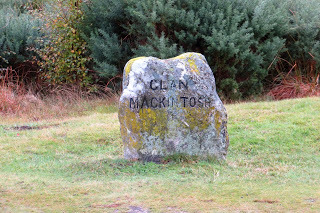 A second marker for Clan MacKintosh
A second marker for Clan MacKintosh
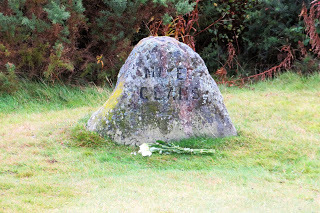 Mixed Clans: There were many other clans represented that day and they too were buried in mass graves.
Mixed Clans: There were many other clans represented that day and they too were buried in mass graves.
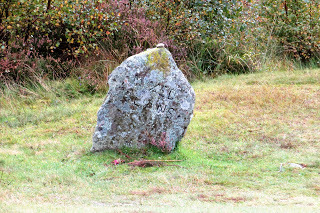 Mixed Clans - Another mass grave of mixed clans.
Mixed Clans - Another mass grave of mixed clans.
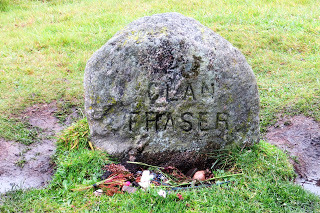 Clan Fraser of Lovat
Clan Fraser of Lovat
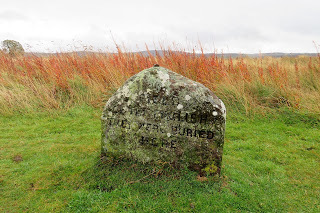 The stone marks where the British soldiers were buried. Approximately 240 to 400 British soldiers were killed.
The stone marks where the British soldiers were buried. Approximately 240 to 400 British soldiers were killed.
What happened to the Bonnie Prince?
Charles ran away from the battle, and although many highlanders saw him and even helped him escape, he was not given over to the British even though a reward of 30,000 pounds was offered. Charles Edward Stuart hid among the moors of Scotland until, disguised as a woman, yes a woman - an Irish maid named Betty Burke, he was put into a boat and taken to the Isle of Sky where a ship awaited to take him to France. He lived in exile the rest of his life, becoming an alcoholic and dying at age 67 of a stroke.
 Monument to The Battle of Culloden
Monument to The Battle of Culloden
It was a thrill to visit Culloden Moor for several reasons. First, it has historical significance to my ancestors and southwestern Virginia. I swear there are as many, if not more, redheads here than in Scotland and Ireland! I also am a big fan of the Outlander series. If you're not a fan, just know that Outlander is a series of books by Diana Gabladon, currently totaling 8, with number 9 coming soon. Outlander is also a TV series on Starz, but this is not a blog about Outlander! I mention it because preparations for the Battle of Culloden Moor begin at the end of season 2 (Dragonfly in Amber) with the battle taking place at the beginning of season 3 (Voyager). A battle they recreated on Culloden Moor that is near Inverness, Scotland.
Historical Significance of Culloden Moor
As is inscribed on the stone monument pictured above, the Battle of Culloden took place 16 April 1746. It was the last battle fought on British soil. It was also the last in a series of battles between the Jacobites and the British that ended the hope of putting James Stuart, a Catholic, on the throne in England, and thus overthrowing the Hanover kings. James Stuart was exiled in Italy, and his supporters were called Jacobites. The Jacobite rising began in 1745 led by James Stuart's son, Charles Edward Stuart, who first tried raising support in France before turning to the Catholic clans of Scotland.
 Charles,whose looks had earned him the description bonnie, the Scottish word for pretty, was known as "Bonnie Prince Charlie" and the "The Young Pretender". Charles first went to France, but the ships he obtained were damaged by storms, so he was forced to abandon France and travel to Scotland. He had many clans who supported him, Catholic and Protestant, so he was able to raise an army of approximately 6,000. Charles was only 26 and lacked military skills, and the victory of early battles such as Prestonpans spurred him on, but the Duke of Cumberland, who was King George II's son, was in hot pursuit. He caught up with him on Culloden Moor, 16 April 1746.
Charles,whose looks had earned him the description bonnie, the Scottish word for pretty, was known as "Bonnie Prince Charlie" and the "The Young Pretender". Charles first went to France, but the ships he obtained were damaged by storms, so he was forced to abandon France and travel to Scotland. He had many clans who supported him, Catholic and Protestant, so he was able to raise an army of approximately 6,000. Charles was only 26 and lacked military skills, and the victory of early battles such as Prestonpans spurred him on, but the Duke of Cumberland, who was King George II's son, was in hot pursuit. He caught up with him on Culloden Moor, 16 April 1746.Culloden Moor


 In the distance are Scotland's flags, marking where the Jacobites stood for battle.
In the distance are Scotland's flags, marking where the Jacobites stood for battle. Prince Charles chose to fight on this flat, boggy land against the advice of his generals, one of which was Lord George Murray. The British had cannons, and the red flags in the pictures show where the British army amassed. The British had 8,000 soldiers. The Jacobites had about 5,000 which consisted of some Irish and French. The Jacobites did have muskets and some artillery, but due to the boggy ground, they had trouble transporting it. The Scots had 200 mounted men to Britian's 800. Many historians believe it was the benefit of Dragoons on horseback with swords and blades that was the biggest advantage in the fight.
Prince Charles chose to fight on this flat, boggy land against the advice of his generals, one of which was Lord George Murray. The British had cannons, and the red flags in the pictures show where the British army amassed. The British had 8,000 soldiers. The Jacobites had about 5,000 which consisted of some Irish and French. The Jacobites did have muskets and some artillery, but due to the boggy ground, they had trouble transporting it. The Scots had 200 mounted men to Britian's 800. Many historians believe it was the benefit of Dragoons on horseback with swords and blades that was the biggest advantage in the fight.
The battle ground has large stones with the names of Scottish clans that mark the places where the clansmen are buried in mass graves. It is estimated that between 1,500 to 2,000 Jacobites were killed, and 154 were captured. Most of those captured were executed.
 This stone has several clan names with one familiar to me in southwestern Virginia: McClanahan.
This stone has several clan names with one familiar to me in southwestern Virginia: McClanahan. Clan Stewart of Appin
Clan Stewart of Appin Clan MacGillivray
Clan MacGillivray Clan MacKintosh
Clan MacKintosh A second marker for Clan MacKintosh
A second marker for Clan MacKintosh Mixed Clans: There were many other clans represented that day and they too were buried in mass graves.
Mixed Clans: There were many other clans represented that day and they too were buried in mass graves.  Mixed Clans - Another mass grave of mixed clans.
Mixed Clans - Another mass grave of mixed clans. Clan Fraser of Lovat
Clan Fraser of Lovat The stone marks where the British soldiers were buried. Approximately 240 to 400 British soldiers were killed.
The stone marks where the British soldiers were buried. Approximately 240 to 400 British soldiers were killed.What happened to the Bonnie Prince?
Charles ran away from the battle, and although many highlanders saw him and even helped him escape, he was not given over to the British even though a reward of 30,000 pounds was offered. Charles Edward Stuart hid among the moors of Scotland until, disguised as a woman, yes a woman - an Irish maid named Betty Burke, he was put into a boat and taken to the Isle of Sky where a ship awaited to take him to France. He lived in exile the rest of his life, becoming an alcoholic and dying at age 67 of a stroke.
Published on October 16, 2018 15:35
No comments have been added yet.



